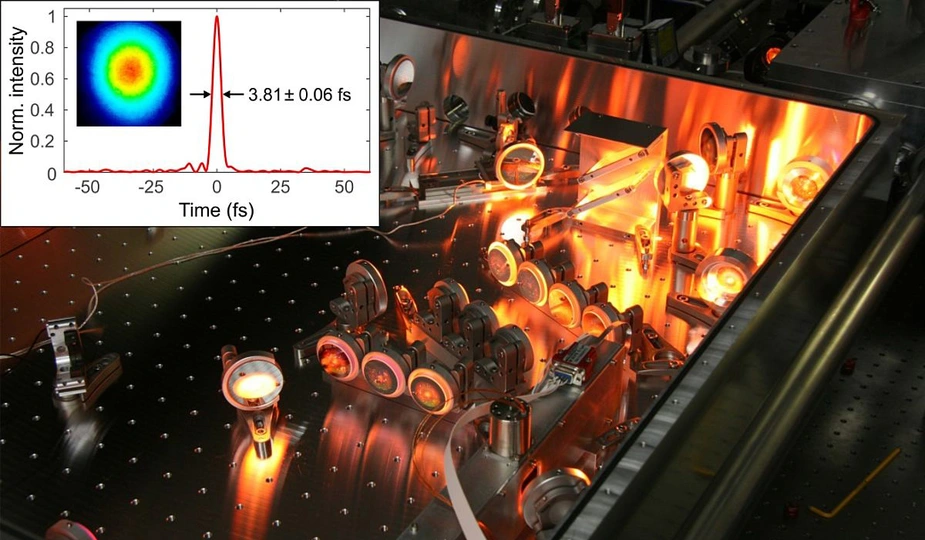MBI researchers set new record for energy scaling of near-infrared light pulses
New compressor delivers above-terawatt 1.5-cycle pulses at kilohertz repetition rate
Researchers at the Max Born Institute for Nonlinear Optics and Short Pulse Spectroscopy (MBI) have reached a new milestone in few-cycle pulse generation, breaking a 10-year-old record and achieving 1.5-optical-cycle-long laser pulses with 1.2 terawatt peak power by a new high-energy hollow fiber compressor beamline.
The intense pulses will be used to generate intense attosecond harmonic radiation for nonlinear XUV spectroscopy studies.
In order to shed light on complex charge transfer mechanisms during the formation of a chemical bond or in biologically relevant processes, one needs tools with exceptional temporal resolution in the attosecond (10-18 s) realm. Single attosecond light pulses can be generated in the extreme ultraviolet (XUV) spectral range by focusing intense few-cycle laser pulses encompassing only a few oscillations of the electric field onto noble gas atoms, using the process called high-harmonic generation (HHG). However, the conversion efficiency is low, yielding very weak attosecond pulses, insufficient for nonlinear spectroscopic applications. In order to create more intense isolated attosecond pulses, high-energy, near infrared, few-cycle driving laser pulses are required.
Now, researchers at the MBI have made a big step forward in the energy scaling of the driver pulses. The group succeeded to spectrally broaden and subsequently compress pulses of a titanium sapphire laser, which emits at a wavelength of 790 nm, to 3.8 fs duration (1.5 optical cycles) at an energy of 6.1 mJ, which is unprecedented at kilohertz repetition rate. Thus the peak power of the pulses exceeds the terawatt (> 1012 W) level. This result breaks a 10-year-old record achieved at RIKEN [1].
In order to achieve these results, a new 8.2 meter long compressor beamline was built around a 3.75 meter long, stretched flexible hollow-core fiber (SF-HCF) where spectral broadening took place as a result of nonlinear interaction between the intense light pulses and helium atoms admitted into the capillary. The spectrally broadened pulses were then compressed by a set of chirped mirrors and characterized by an in-line dispersion scan device that was directly placed into the vacuum beamline that is constructed for subsequent high-harmonic generation and XUV experiments. The new HCF compressor is an up-scaled version of a device that was recently developed in the framework of an international collaboration with participation of the MBI [2].
This new development paves the way towards table-top nonlinear attosecond XUV spectroscopy.
References:
1. S. Bohman, A. Suda, T. Kanai, S. Yamaguchi, and K. Midorikawa, Generation of 5.0 fs, 5.0 mJ pulses at 1kHz using hollow-fiber pulse compression, Opt. Lett. 35, 1887-1889 (2010)
2. M. Ouillé, A. Vernier, F. Böhle, M. Bocoum, A. Jullien, M. Lozano, J.-P. Rousseau, Z. Cheng, D. Gustas, A. Blumenstein, P. Simon, S. Haessler, J. Faure, T. Nagy, R. Lopez-Martens, Relativistic-intensity near-single-cycle light waveforms at kHz repetition rate, Light: Science & Applications 9, 47/1-9 (2020)
Original publication
Generation of above-terawatt 1.5-cycle visible pulses at 1 kHz by post-compression in a hollow fiber T. Nagy, M. Kretschmar, M. J. J. Vrakking, A. Rouzée Optics Letters 45 (2020) 3313-3317 URL, DOI or PDF
Contact:
Max-Born-Institut für Nichlineare Optik und Kurzzeitspektroskopie (MBI)
Dr. Tamás Nagy
Tel. +49 30 6392-1270
E-Mail Tamas.Nagy(at)mbi-berlin.de
Anja Wirsing
Pressereferentin
Press Officer
Forschungsverbund Berlin e.V.
Rudower Chaussee 17
12489 Berlin
+49 30 6392-3337
wirsing(at)fv-berlin.de
www.fv-berlin.de
www.facebook.com/ForschungsverbundBerlin
twitter.com/FVB_adlershof
MBI Press release of 17 June 2020
